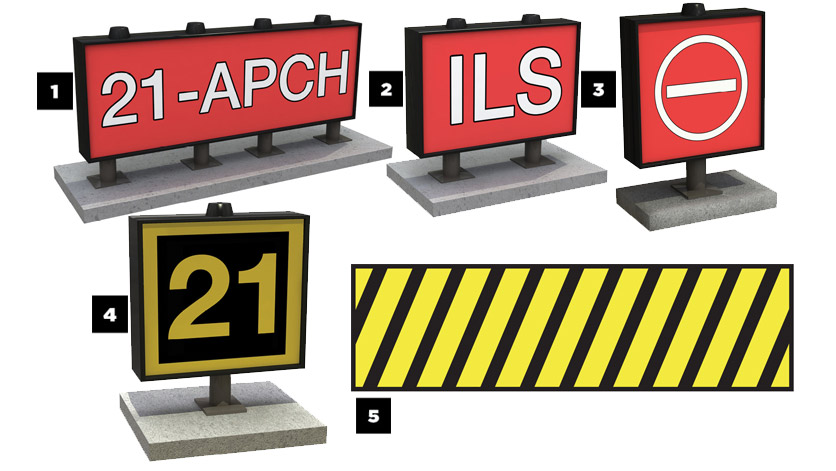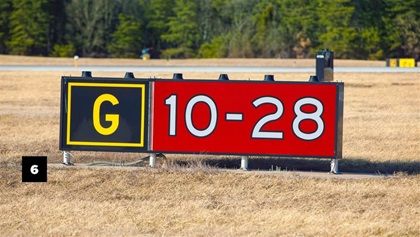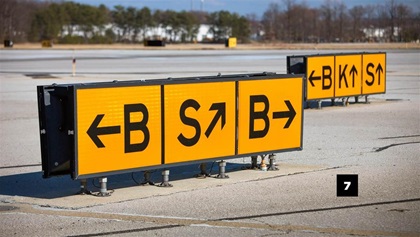Do this, don’t do that
Can’t you read the signs?

Like road signs, airport signs let you know where you are, where to turn to get to where you want to go, and a whole lot more. At first glance, the sign ecosystem seems as overwhelming as the Minotaur’s Maze they occupy—but here’s a secret: Despite the incredible range and variety of signs populating airports, there are actually only six kinds. They are mandatory instruction signs, location signs, direction signs, destination signs, information signs, and runway distance remaining signs.
And like road signs, they are color-coded to help you know at a glance what kind of sign they are.

Illustration by Charles Floyd
Not an option
We all know that red means stop in the world of wingless machines. The same is true of mandatory instruction signs. These red backgrounded signs with white letters, numbers, or symbols—called inscriptions by the Aeronautical Information Manual (AIM)—indicate areas where airplanes must stop, such as the entrance to runway, along with areas where aircraft are prohibited altogether. There are four subspecies of mandatory signs:
Runway holding position sign: Located at taxiway entrances to runways, these signs function like stop signs at nontowered airports, and more like traffic lights at towered airports. At nontowered airports upon reaching the sign, stop, look, and listen before taking the active runway. At towered airports, this sign marks the location where airplanes must hold short of the runway for clearance to enter or cross. Shown as a pair of runway numbers separated by a dash, the sign is oriented for cockpit perspective: 8/26 tells the pilot that the threshold of Runway 8 is to her left while the threshold of Runway 26 is to her right. If there were a taxiway in exactly the same position on the opposite side of the same runway, the sign there would read 26/8. When the taxiway intersects the beginning of the runway, a single runway number may be shown instead. In cases where a taxiway connects to a runway intersection, both runways will be shown with pointer arrows indicating the directions of the thresholds.
Runway approach area holding position sign: In some cases, taxiways may cross under the approach paths of runways, necessitating a band of pavement that requires clearance to proceed across. These signs will show the runway number along with the letters APCH.
ILS critical area holding position sign: White “ILS” on a red field, this sign denotes the start of an ILS critical area. At a towered airport you only need to hold short at this sign if instructed to do so. At a nontowered airport, it’s more complicated: Hold short if the ceiling is less than 800 feet, visibility is less than 2 miles, and there is an airplane on final approach. Once the airplane lands, you can cross the zone.
No entry: This red sign with a white circle around a long dash indicates one-way taxiways, airport vehicle roadways, or closed areas that aircraft should not enter.
Where are you?
Location signs are like the road signs you’re used to seeing as you cruise down the highway: You’re on Route 66. Or Interstate 95, State Highway 51, or Country Road B45. These signs tell you where you are. The most common for pilots is the taxiway location sign. It features a black background with a yellow inscription, surrounded by a yellow border on FAA signs (overseas, ICAO has dispensed with the border).
Taxiways are named with letters, so the inscription will be a letter, such as A, or two letters like AA if the airport is so large it ran out of letters. The letters I and O are never used, as they can be mistaken for numbers, and the letter X is not used as it can be misconstrued as meaning the taxiway is closed. There may also be a mix of letters and numbers such as A2, A3, A4, typically used when short taxiways connect to a longer taxiway parallel to a runway.


Many generations of student pilots have learned this sign by Martha King’s “black square, you’re there!” guidance. But if you see the same sign with a number and no letter, it’s a runway location sign, instead, and it means you’re on a runway. If you didn’t intend to be, you’re in trouble, and possibly in danger.
Overseas, there’s also a taxiway ending sign that looks like a taxiway location sign with the addition of a yellow slash from the lower left corner to upper right corner behind the name of the taxiway. It’s quite rakish. In the United States, we use a large rectangular sign at the end of the taxiway that features bold black and yellow hashed stripes diagonal across the sign—similar to a road-closed sign that you might see across a road whose bridge has washed out.
There are other subtle differences between FAA and ICAO signs but the broad strokes are the same. If you find yourself landing in Paris (hey, it could happen) you’ll make out OK with your hometown knowledge.
Lastly, there are two other location signs: runway boundary and ILS critical area boundary. The former, as the name suggests, lets you know when you are clear of the runway when exiting onto the taxiway. As you might have suspected, it depicts the hold short line symbology with bold black graphics on a yellow background. The ILS critical area boundary sign has the same color scheme and looks like a ladder lying on its side. It alerts you to the fact that you’ve cleared the ILS critical area.
So you don’t have to stop and ask for directions…
We’re back on the road. Oh, look, there’s an exit. The sign says we can leave the highway now and join up with Country Road C5. In the same way we have exit signs on the highway, we have direction signs at airports. Typically used at taxiway intersections, these signs have a solid yellow backgrounds with black letters (or letters and numbers) indicating taxiway names, and pointer arrows showing the orientations of the intersecting taxiways.
These signs can get pretty crazy when multiple taxiways create complex intersections. Tip: The direction signs are arranged like the tile holder of the Scrabble board game, with individual “tiles” indicating the taxiway choices clockwise from the pilot’s left, and will include our friendly black “we’re there” square somewhere in the middle. Also, the sign will appear prior to the intersection. Obvious when there’s one intersection, but when there are three turns with corresponding signs, it can be helpful to know.
Vacation getaway destinations
Memphis next exit. Yes, on the highways and byways we have signs to let us know where to exit to get to somewhere we want to go. Likewise, at airports we have destination signs. These signs look much like direction signs with black writing and arrows on a yellow field—but now we have truncated words, of at least three letters, and usually more.
When all roads lead to Rome, a sign may have to do double duty, or even triple duty. In this case a black dot appears between the inscriptions with a single arrow pointing the way. A final direction sign is the runway pointer, which simply gives the runway number, and a direction arrow to indicate the direction of taxi to reach it.

Illustration by Charles Floyd
The 4-1-1
Still sharing the black on yellow motif are information signs. As the name suggests, these signs provide us with “good to know” kinds of information. It might be radio frequencies, noise abatement procedures, density altitude reminders at high altitude airports, and even notices that terrain blocks the view an intersecting runway!
Distance to end of the Earth (well, the paved part, anyway)
Our final sign is black and white. Literally. White numbers on a black background. These large signs are placed along the edges of the runway, and are used to alert you to how much usable runway is left in thousands of feet. For instance, a runway distance remaining sign with a giant 2 on it tells you there are 2,000 feet of runway remaining.
Mix-and-match
Of course, the various types of signs can be, and frequently are, mixed and matched. The AIM calls these “collocated” signs. It’s common to see a red runway hold sign together with a black-square-you’re-there sign. Also, commonly collocated are multiple taxiway direction signs, which—at larger airports with more complex runway and taxiway layouts—can lead to very long signs made up of seven or more elements. Talk about Scrabble double points!
Oh. Right. I guess I led you astray. There’s actually a seventh kind of sign found at airports: Vehicle roadway signs for our non-winged brethren that share the pavement with us. Fuel trucks, baggage trains, maintenance vehicles, security patrols, and the like. These signs look pretty much like regular road signs you’re used to, with the possible exception of the one that cautions: Yield to aircraft.



